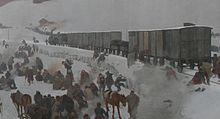Compagnie Franco-Suisse
| Franco-Suisse (FS) | |||||||||||||||||||||||||||||||||
|---|---|---|---|---|---|---|---|---|---|---|---|---|---|---|---|---|---|---|---|---|---|---|---|---|---|---|---|---|---|---|---|---|---|
|
|||||||||||||||||||||||||||||||||
The Compagnie Franco-Suisse (FS), or Franco-Suisse for short , was a Swiss railway company that existed from 1859 to 1871 .
history
Foundation and construction

A committee founded in 1852 pursued the goal of establishing a connection to the French railway network with a railway line from Neuchâtel via Les Verrières to Dole . To continue the line from Neuchâtel to Zurich ; the committee got in touch with the Swiss Northern Railway (SNB) in Zurich. The project failed due to the resistance of the canton of Neuchâtel , which on December 16, 1853 granted the concession for a line from Les Verrières through the Val de Travers to Neuchâtel and on to the Bemer border at Thielle , as well as for a branch line from Neuchâtel to the Vaudois border at Vaumarcus granted. With the support of the French Paris – Lyon – Mediterranean Railway (PLM), the Compagnie Franco-Suisse was founded on April 2, 1856 . PLM took a 40 percent stake in the share capital of 12 million francs.
On November 7, 1859, the company was able to open the route from Vaumarcus - where the line of the Compagnie de l'Ouest Suisse (OS) from Yverdon ended - to Frienisberg on Lake Biel . The route section forms part of the Jura foot line, which has been passable continuously since 1860 . At the La Russie bay in Frienisberg, a provisional train station with a port for the ship connection to Nidau near Biel was built .
On July 25, 1860, the line (Neuchâtel–) Auvernier – Pontarlier followed on the Jura foot line to Les Verrières on the Swiss border , where it was connected to the PLM's Frasne – Les Verrières line . The construction of the line turned out to be quite difficult and required numerous engineering structures. In order not to exceed the maximum gradient of 20 ‰ between Auvernier and the apex in Les Bayards , the route often had to be laid in rock cuttings and tunnels. The construction claimed four lives. Initially, PLM was responsible for transporting trains on both routes and also provided the rolling stock. International trains soon arrived from Paris via Les Verrières to Neuchâtel.
Operating group Suisse-Occidentale

The connection from Neuchâtel via Lausanne to Geneva was in the hands of three companies, which often fought one another. Franco-Suisse owned the section to Vaumarcus, the line from Vaumarcus to Versoix belonged to the OS, the short section from Versoix to Geneva was in the hands of the Lausanne – Friborg – Berne Railway (LFB). The three competing western Swiss railways got into financial difficulties. The Swiss Central Railway (SCB) handled a large part of the traffic going to France via its border point in Basel. After long and difficult negotiations, the FS, the OS and the LFB founded an operating group on January 1, 1865 called the " Association des chemins de fer de la Suisse Occidentale ". The company was bought by Laurent-Bergeron et Comp. At a price of CHF 8,000 per kilometer per year. transfer. The financial situation of the three railways in western Switzerland stabilized and from 1868 onwards the operating group was able to pay a very modest dividend every year .
Franco-Suisse played an important role in the Franco-German War when the French Armée de l'Est with 87,000 men under General Bourbaki was interned in Les Verrières in January and February 1871 . During the evacuation of the interned troops, a clash occurred on March 22, 1871 as a result of a wrong switch. The platoon leader and 22 internees were killed and 72 soldiers were injured, some seriously. ( see also section railway accident of March 22, 1871 in article Colombier NE )
On January 1, 1872, the Suisse-Occidentale (SO) was formed as a stock corporation in which the Franco-Suisse was fully integrated together with the OS and the LFB. With a network length of 315 kilometers, the then largest railway company in Switzerland was created.
Rolling stock
Since the management was first carried out by PLM and then by the SO operating group, Franco-Suisse did not have its own vehicles.
swell
- A century of Swiss railways 1847–1947 . Verlag Huber & Co. AG, Frauenfeld 1947; Volume I, p. 80
- Hans G. Wägli: Swiss Rail Network . General Secretariat SBB, Bern 1980.
- 3 × 50 years - Swiss railways in the past, present and future . Pharos-Verlag, Basel 1997; Pp. 71-73
- Placid Weissenbach : The railway system in Switzerland. (PDF 14.8 MB) First part. History of the Railway System. 1913, p. 66 , accessed February 1, 2014 .
- Franco-Suisse In: bahndaten.ch. Data on the Swiss railways 1847–1920 . Thomas Frey and Hans-Ulrich Schiedt, ViaStoria, accessed on February 1, 2014.
- Alfred Moser: The steam operation of the Swiss railways 1847-1966 . Birkhäuser Verlag Basel and Stuttgart 1967
Remarks
- ^ Association of Western Switzerland Railways

